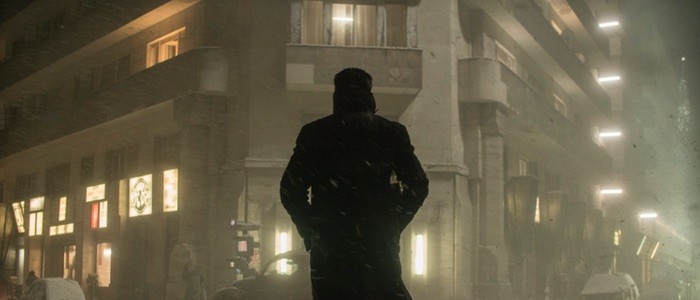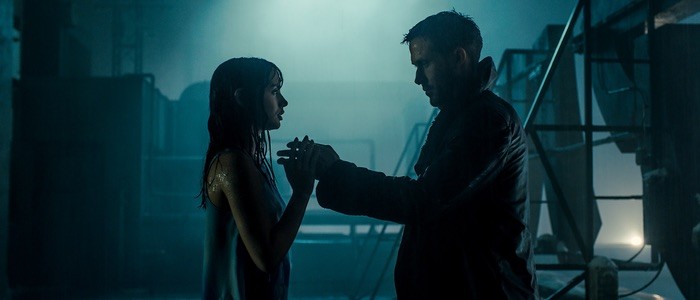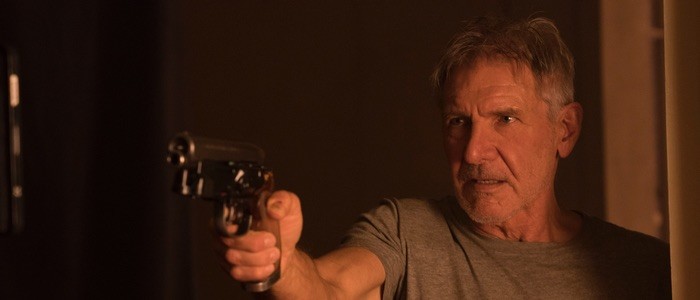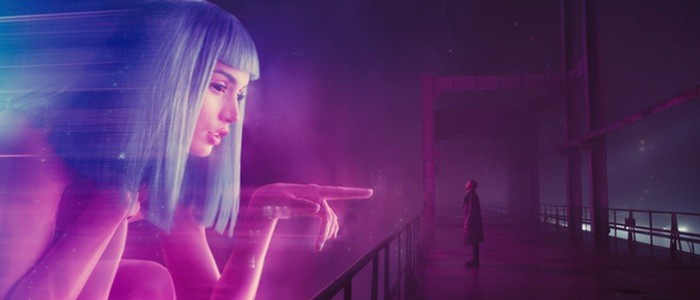More Human Than Human: A 'Blade Runner 2049' Spoiler Review
(In our Spoiler Reviews, we take a deep dive into a new release and get to the heart of what makes it tick...and every story point is up for discussion. In this entry: Denis Villeneuve's Blade Runner 2049.)Any review of Blade Runner 2049 is by default a spoiler review. Warner Brothers and director Denis Villeneuve have gone to extreme lengths to keep the majority of details about their sci-fi sequel a secret, including limiting press screenings and issuing stern warnings to the press who did see the film to not reveal anything. This is both a commendable and unfortunate approach. While it's true that movie marketing tends to give away too much for many films, and going into a film cold can make for a more rewarding experience, the tight-lipped approach to Blade Runner 2049 may have inadvertently doomed it at the box office. Audiences knew so little about the film from its less-than-engaging trailers that they simply didn't bother to attend.Which is a shame, because Blade Runner 2049 is one of the very best films of 2017, and one of the most staggering big studio releases you're likely to come across. How on earth did Denis Villeneuve convince Warner Brothers to let him make a gigantic, foreboding tone poem and dress it up as a Blade Runner sequel? We may never know, and if the film continues to underperform, we may never get so lucky again.So how about we dive into a Blade Runner 2049 spoiler review and talk about what makes this movie work so well?
You’ve Never Seen a Miracle
The opening to Blade Runner 2049 will seem familiar to anyone who has studied the making of the original film. Hampton Fancher, who co-wrote 2049 as well as the original Blade Runner, was able to port over the unused opening in an earlier draft of what would become the 1982 Ridley Scott film. In that unused scene, Harrison Ford's Deckard would be waiting for a man in the man's home. Here's how Paul M. Sammon, author of Future Noir: The Making of Blade Runner, explains the original scene:
"The original idea was to have Deckard be sitting in the kitchen and through the windows, you see the day is getting darker and darker ... a strange vehicle pulls up. A guy in farmer's overalls comes out, goes into the house, sees Deckard sitting there, ignores him, walks into the kitchen and starts stirring a big pot of soup...He says, 'Do you want any soup?' Deckard doesn't say anything. 'Who are you with, anyway?' this guys says while stirring. Deckard gets up and says 'I'm Deckard, Blade Runner.' Boom! He kills this guy for no reason. Just shoots him. And then as this guy slumps against this wall, falls to the floor, Deckard reaches into his head and pulls his lower jaw out. And you see that it is an aluminum construct with an ID number stamped on it, and you realize it is not a person, it is a robot. Deckard takes this, puts in into his trench coat and walks out of the farm house, across the field."
In Villeneuve's Blade Runner 2049, it's no longer Deckard waiting in a kitchen for a confrontation, it's Ryan Gosling's K. Decked out in a stylish trench coat (everyone in the Blade Runner universe gets to sport really cool coats), K has come to confront Sapper Morton (Dave Bautista). Sapper is a replicant – aka robot – in hiding, and K is a Blade Runner, a special type of cop whose job it is to "retire" (kill) renegade replicants who have outlived their purpose. In the Blade Runner world, replicants are slave labor, used for a variety of tasks – physical labor, for instance, or pleasure in the form of sex worker robots. As long as replicants perform their tasks and remain complacent, they're able to get along fine. But if they disobey their commands and begin acting with a mind of their own, it creates a problem. That's where Blade Runners come in.And here Blade Runner 2049 reveals one of its first big twists; one of the many things the trailers avoided revealing: Gosling's K is also a replicant. Sapper Morton is a completely different model than K, but they're both robots created to serve and obey. "How does it feel to kill your own kind?" Sapper asks K. The two engage in a brutal struggle. K eventually gets the upper hand, killing Sapper. But before Sapper's death, he cryptically speaks about witnessing a "miracle." This miracle will be central to Blade Runner 2049's plot. Because K makes a discovery on Sapper's property – a box of bones buried beneath a dead tree. The bones appear human, but they actually belong to a replicant. And not just any replicant – they belong to Rachel, Sean Young's character from the first film.The question must be asked now: do you need to have seen the first Blade Runner to understand any of this? The answer, surprisingly, is no. One of Blade Runner 2049's strengths is the way it goes to great lengths to stand on its own while also tying into the original film. Yes, seeing the first Blade Runner improves the experience. But if you happened to go into this sequel having not seen the first (why you would do that I don't really know), you'd still be able to comprehend what's happening here.And there's a lot happening here. Blade Runner 2049 is an altogether overwhelming experience. Almost nothing can accurately prepare you for how complex, and rich, and foreboding this film is. Certainly not in terms of modern studio blockbuster filmmaking. Alcon, Sony and Warner Brothers, the companies that financed and distributed Blade Runner 2049, have gone all-in on releasing a film that cost at least $155 million, and probably more. This is an exorbitant sum for any movie, let alone a film that's a sequel to a sci-fi flick that underperformed when it hit theaters in 1982. Ridley Scott's Blade Runner may be regarded as a classic now, but when Scott's smoky, gloomy, future noir graced cinemas in the '80s, not a whole lot of people got it. Worse, not a whole lot of people went to see it.Yet the studios behind Blade Runner 2049 were apparently okay with shelling out big bucks to get this film made. With that mind, it would've been very easy for them to insist on something much more digestible to everyday audiences. A type of big, dumb shoot-em-up that doesn't require much thought and leaves general moviegoers with a sense of entertainment and little else. But that's the complete opposite of what Blade Runner 2049 is. It's a haunting, strange meditation on what it is to be human. An overarching theme in the science fiction films Ridley Scott has been involved with rests on how despicable and unlikable humanity can be, and how easy it can be to sympathize with the synthetic. In Blade Runner, Rutger Hauer's Roy Batty was the villain, but he was also easy to root for. We felt bad for him, and we understood his needs – he wanted more life.Blade Runner 2049 gets that, and in turn makes its main character a replicant. K, too, wants more life, although he may not quite realize that at the film's start. He seems content to serve his purpose – to go to work and report back to his superior (Robin Wright). But as he's drawn further and further into the film's central mystery, the more and more he wants out of life. Whatever life is. K is, technically speaking, a thing without a soul. He's not human, but he behaves more humanely than the actual humans in the film. He has needs, and feelings, and wants. Are they genuine, or just programmed? Is he really even feeling anything, or are these feelings the result of some circuitry?
All These Moments
Any review of Blade Runner 2049 must mention the jaw-dropping cinematography courtesy of Roger Deakins. Deakins, one of the very best cinematographers in the biz who lensed films like The Assassination of Jesse James and Sicario, outdoes himself, and virtually everyone else in his field, here. From the very start of Blade Runner 2049, the look and feeling of this film is overwhelming. The original Blade Runner employed stunning visuals as well, but they're nothing compared to what Deakins creates here.I can't remember another film that so quickly pulls you into its world as this. Blade Runner 2049 doesn't just engross you, it absorbs you. You are enveloped by its overwhelming, overbearing presence. Deakins and Villeneuve slowly guide the audience through a dizzying world of skyscrapers towering above smoky, neon-lit structures. The first Blade Runner felt claustrophobic – with everything crammed together. Here, the world opens up, and it continues to open up all the way throughout. The script travels beyond futuristic Los Angeles to places beyond, like a Las Vegas awash in a sickly orange light, and a San Diego that's become a city-wide junkyard.There are times when the camera tilts up into the sky that you may find yourself feeling faint, as if you'll fall up into that sky; as if gravity will cease to function properly, and pull you into the world on display here. Don't be surprised if you come out of the film in a daze.This isn't to say Blade Runner 2049 is all spectacle and no story. There is story here, and a surprising amount of emotion. For a film dealing with cold, analytical characters, there's a beating heart at the center of Blade Runner 2049.The mystery K uncovers involves a shocking discovery: it seems Rachel gave birth to a child. This very concept has the power to break the world, according to K's superior. She's right – if a replicant can suddenly reproduce, the implications are staggering.Niander Wallace (Jared Leto), the creepy inventor whose company produces replicants now (having absorbed the Tyrell Company from the first film) realizes that he'll never be able to engineer enough replicants to achieve total control over everything. Replicants that can reproduce on their own could very well change this forever, and he wants to find the child that Rachel gave birth to and use it for this benefit. He employs his right-hand woman/replicant Luv (Sylvia Hoeks) the task of finding the child, which she does by tracking K.Leto is probably the weakest link here. He's nowhere near as dreary as he was in Suicide Squad, but he's also clearly the only actor in the film who seems to be Acting with a capital a. I don't mean he's the only one trying – I mean he's the only one who looks like he's trying too hard. The character is effectively creepy and off-putting, but Leto seems to be working overtime to sell it all. Much more effective is Hoeks, as the murderous Luv. Looking absolutely badass as she gets a manicure while calling in drone strikes, Luv may not be as memorable and iconic a villain as Hauer's Roy Batty, but she still makes quite an impression.K, meanwhile, deals with his own issues. Those issues involve his girlfriend Joi (Ana de Armas), who is another of the film's unexpected twists. The trailers hinted at this character as K's love-interest, but she's not just some simple girlfriend character. She is, in fact, a form of artificial intelligence. A creation meant to pleasure whomever owns her. Think of her as Scarlett Johansson's AI character from Her, but with a body. That body is a kind of digital projection, which results in some of the film's most haunting imagery. While Joi seems to be physically there in certain scenes, she's also translucent in certain lighting. Backlighting will often shine through her, rendering her almost ghostly. De Armas is fantastic in the role, juggling a part that's both artificial and human.There is, of course, something to be said about this character and Blade Runner 2049's approach to women. Save for Wright's character and one other which we'll get to shortly, the women in Blade Runner 2049 are subservient products, created solely with the purpose of pleasing their male counterparts. This is appalling for sure, but I don't think Blade Runner 2049 wants it to be anything but appalling. This film is, after all, set in a dystopia. It's not trying to give the implication that anything happening here is ideal.But the film is also asking tough questions that don't have clear answers. Yes, Joi is not "real" in a sense, but neither is K. Yes, Joi has been programmed to serve her owner – in this case K. But K has also been programmed to do a job, and he eventually resists this programming to forge his own path. Does Joi also have this ability? Is she perhaps truly sentient and serving her own interests, or is she merely doing exactly what she's supposed to do? Blade Runner 2049 never gives a clear answer to this, and that will likely frustrate some and inspire a few think pieces. That's fine! Movies should do that. Movies should be willing to raise difficult questions with answers that you may not like. It's when we make the mistake of thinking a movie is condoning a less-than-desirable answer that we begin to err.The relationship between K and Joi leads to one of the film's most incredible scenes, although again, the politics of the scene are up for question. Unable to physically touch K, Joi hires a replicant prostitute (played by Black Mirror's Mackenzie Davis) to be her physical stand-in for a night of lovemaking. Joi is able to "sync" with Davis' character, but during the course of the scene, the two women can be seen switching back and forth, with Davis' features sometimes appearing on de Armas' body and vice versa. It's perhaps the most original sex scene in recent film history, but it will no doubt raise an eyebrow or two. As it should. Again, what makes Blade Runner 2049 so unique is the way it presents these challenging situations and then steps back and lets its audience draw its own conclusions.
Tears in the Rain
During the course of his investigation, K pieces together that the father of Rachel's child is missing Blade Runner Deckard (Ford). He also begins to suspect, thanks to a memory that he's long thought was implanted but may in fact be genuine, that he himself is the missing child.
He's not.
The film does a very good job of both making this twist obvious while also making us believe it might be true. A lot of this has to do with the way Gosling plays the character, and how he evolves over the course of the film. When he first discovers that the memory from his childhood – involving a horde of bullies and a carved wooden horse – is real, he has a complete meltdown. Yet later he begins to long for the realization to be true. He wants to be that special child. He wants to be more human than human.In the last few years, Gosling has proven what remarkable range he has. Looking at his characters in La La Land, The Nice Guys and now Blade Runner 2049, it's remarkable to realize they're all the result of the same actor. This is one of Gosling's most controlled performances, comprised of moments of stillness punctuated with bursts of violence, and the actor handles it perfectly. It is by no means a showy performance, which might result in many to undervalue it.K tracks down the person whose job it is to create false memories for replicants. These memories serve to make the lives of replicants better – they're less prone to misery and despair if they have some sort of memory to cling onto, no matter how fake. The memory maker is Dr. Ana Stelline (Carla Juri), sequestered in a glass room due to an immune deficiency. Juri isn't in much of the film, but her performance is remarkable. In the first of her two scenes, she constructs a memory with the precision of a painter creating a work of art, and Juri handles all of this remarkably well, bringing such raw emotion into the way she describes her process. When K asks her if she's ever used real memories to create memories for replicants, listen to the way Juri says "Using real memories is illegal." The slight inflection she puts on the words; the knowing smile she has when saying them. She's telling us everything we need to know here, we just don't know it yet.K's investigation leads him to the abandoned, orange-tinged remains of Las Vegas, where he finally confronts Deckard. Harrison Ford shows up much later in this film that I think anyone might be expecting. Ford is all over the deliberately vague marketing, so some may be expecting him to be a co-star to Gosling here. That's not exactly what happens. Yet Ford's performance is wonderful and essential to making Blade Runner 2049 work as well as it does. The actor, who in his later years had seemed to settle into the role of a gruff curmudgeon not really concerned with giving good performances anymore, has seemingly found a second wind revisiting his classic roles. He was lively and charming in Star Wars: The Force Awakens. Here, gets to be gruff and standoffish, but there's a longing Ford brings to the role that's quite astounding. Here, Deckard is filled with a sadness and regret the likes of which we haven't really seen from Ford ever. "Sometimes to love someone, you gotta be a stranger," Ford's Deckard growls at one point, and the line is heavy with remorse thanks to how Ford delivers it.The film's most emotional moment features no dialogue from Ford at all, but involves him nonetheless. By the film's conclusion, Deckard is believed to have been killed, which means no one can use him to find his missing miracle child. Which means after 30 years of remaining a stranger, and staying far, far away, he can see her again. The child is, of course, Dr. Ana Stelline. She's been only lead to believe she has an immune disease which keeps her isolated, when really her isolation was a way to protect her from those would want to dissect her and find out just what she is.When Deckard enters the facility where Ana lives, she's working on new memories. This time, a memory of snow, which swirls around her in her glass containment area as if she were trapped within a snow globe. She doesn't know who Deckard is, and she doesn't even turn to face him."Beautiful, isn't it?" she asks.Here, Villeneuve cuts to Ford, standing on the other side of the glass. A slight smile turns up the corner of his mouth, and he places his hand firmly on the glass. It's quick, and it's small compared to the rest of what we've seen, but it's the most human moment in the film, filled with longing and hope. Filled with second chances. It's awe inspiring. And then it's over.
The Future
Blade Runner 2049 is, at the time of this writing, a box office disappointment. Domestically, the film took in $31.5 million, which is short of the early estimates. I can't say I'm surprised. The film was a sequel to a cult phenomenon, and the deliberately obtuse trailers didn't do it any favors. Plus, while Gosling and Ford may be respected, they're not exactly box office juggernauts. Blade Runner 2049 was always going to be a tough sell. It's also nearly three hours long, which can be overwhelming.Yet while I'm not shocked the film underperformed, I am of course disappointed. This is a big, challenging, complex film. It struggles with issues of humanity, and life, and death, and beyond. It conveys it all in a grand, beautiful fashion, full of stunning moments that are unlike anything you've ever seen in a modern movie. This is a film to be studied, and marveled over, and revisited in years to come. It's a Blade Runner movie, in other words.It would be nice if audiences would reward such innovation. It would be nice if audiences would stop shelling out endless money for the same old same old and throw some of it at something different. Yes, Blade Runner 2049 is a blockbuster sequel, which means it may not be the most original idea of all time. Yet it's approach to such material is so different, so unique, that it's hard to think of this film as anything but original.Sequels will come and go, and it might be some time before Hollywood throws this much money and this much prestige at a franchise staple like this. But at least we have this movie for now. It is a film that cries out to be seen on the biggest screen possible. To be experienced. It should've drawn more of a crowd. It should've received a warmer reception. In the end, it's too bad Blade Runner 2049 won't live at the box office. But then again, who does?
